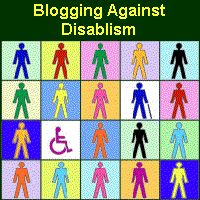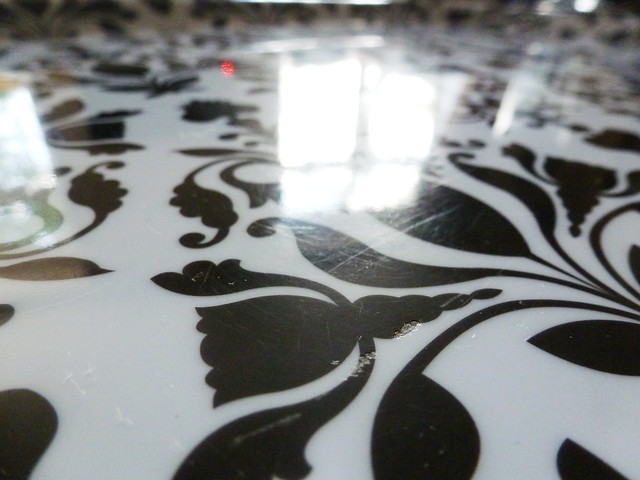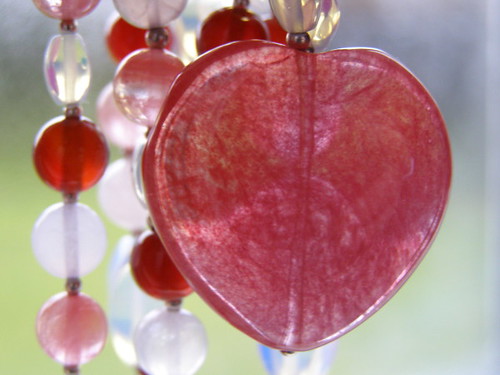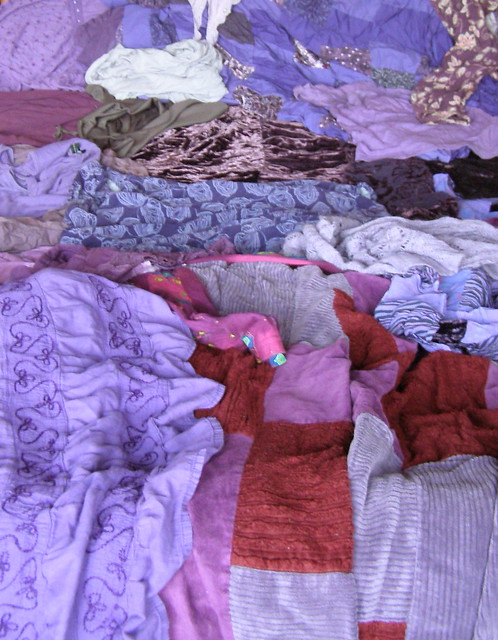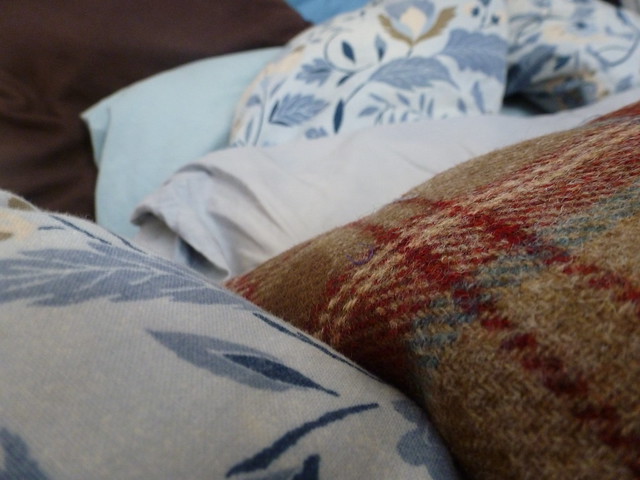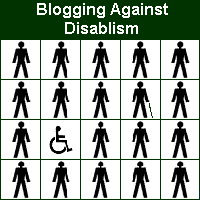 |
Full image description and attribution at the bottom of the post.
There is a widespread belief in our culture that raising Awareness of illness and impairments benefits disabled people. Even if it were possible to educate the general public about every medical condition there is, this doesn't do anything to address the attitudes which cause inequality. In fact, I would argue that Awareness thoroughly supports those attitudes; disabled people are to be pitied, and if they can't be pitied, they must be hated.
Awareness is about Money.
Awareness Campaigns are primarily money-raising exercises. They raise money for charities and they provide very cheap human interest stories to fill magazines, newspapers and TV shows. Some charities are extremely worthwhile causes, but others are not - the mere association between an organisation and a group of people who need help and support doesn't mean that that help and support is forthcoming.
Meanwhile, as I've been looking around for graphics to illustrate this post, I have learned that one can buy a great number of Awareness t-shirts and accessories from companies who don't even feign affiliation to a charity. So there's money to be made all round.
Awareness reinforces a strict narrative about disability.
It's tremendously important that disabled people tell our stories - all kinds of stories - but there are only three stories told about disabled people in our culture; triumph, tragedy or villainry. Awareness leaves the villains alone - nobody gives their spare change to help Blofeld walk again.
Instead, Awareness concentrates on the narrative which makes up The Tragedy Model of Disability:
 |
| "Keep Calm and Fight Depression" |
2. Our hero bravely battles against impairment.
3. The bittersweet resolution, which may be:
(a) Our hero succeeds in becoming at least slightly less disabled.
(b) Death and thus, the end of suffering.
Almost every news story and most fictional stories involving disabled characters follows this pattern. Awareness Campaigns' favourite subjects start out as brave soldiers, promising athletes or straight-A students - all the better if they are about to get married or start their dream job when they become disabled. Obviously, they have to become disabled in a way where they are blameless; for reasons that remain unclear, extreme sports injuries are fine but sexually-transmitted diseases are not.
Then they have to suffer; multiple tests, multiple surgeries, multiple experiments in alternative therapy, moments of despair (but preferably nothing as serious as a suicide attempt). And at the end, even though most subjects will still be disabled, it has to be played that they have overcome their impairment in some way. They may have defied all expectations to taking up macrame! Or they have a relationships! Or even a job!
 |
| "Losing is not an option" |
Quite unlike when non-disabled children suffer violent death at the hands of their caregiver - that is the worst thing in the world.
Awareness promotes a dynamic between non-disabled and disabled people which renders equality inconceivable.
I've written before about the way that doing anything for disabled people, including normal things that family members, friends and colleagues do for one another all the time, can be framed as care and take on a special charitable status. Give your non-disabled friend a lift? That's a favour. Give your disabled friend a lift? That's care, have a medal, bask in the warm-fuzzy of your own philanthropy.
 |
| "I wear a ribbon for my hero" |
This is a major factor in the abuse of disabled people, with disabled women twice as likely and disabled children three times as likely to experience domestic abuse than their non-disabled peers. Stand next to a disabled person and you'll be assumed to be their carer. Live with one and you'll be assumed to be a saint (see above, re the New Malden murders).
A little knowledge is a dangerous thing.
Once I'd received my diagnosis, friends and family would take an interest in news stories about the Dreaded Lurgy. Most of these stories were human interest stories of the Awareness variety; stories about someone with the Dreaded Lurgy. A Day In My Awful Life or My Life-Plan Down The Pan - this sort of thing. I did meet one of my best friends through one such story, but hers was told with far more stoicism and grit than the others.
Anyway, these people with my diagnosis were, naturally, a complete mix. In some cases, I didn't even look like those people; the drugs I was on had made me fat, while some featured dangerously underweight women who struggled to keep any food down. Some of them described managing a part-time jobs, while I was rarely awake for a full hour stretch. Others couldn't walk or even talk, while I was relatively ambulant and nattering away just fine.
Thus, my diagnosis was gently questioned by well-meaning friends and family all the damn time. This was only sometimes skepticism about my account of things - usually the hope was that the doctors had missed something and maybe there was a cure for what ailed me.
Awareness places different conditions in competition with each other.
 |
| "I wish I had breast cancer" - Poster for Pancreatic Cancer Action |
While there is a large degree of solidarity within the disabled community (hierarchy notwithstanding), communities built around a shared diagnosis are not always sympathetic to other disabled people. It is obviously true that some diseases are generally nastier than others, that some diagnoses are better understood than others and so forth. But, with the help of self-interested charities, illness-based communities can often lead themselves to believe that their problems are unique. Awareness promotes this mentality, pitching one condition against another for sympathy, attention, charitable donations and occasionally even government resources; I have seen on-line petitions demanding funding for very specific areas of research.
When the Robot Hugs cartoon Helpful Advice went viral with the caption “If physical illness was treated like mental illness” (not the artist's own words) it appeared in my Twitter stream on a daily basis for over a week. And every time I saw it, I despaired. People with chronic injuries and physical illnesses get advice about trying harder, thinking positive, avoiding essential medication and so forth all the time. Yes, the stigma of mental illness is undoubtedly worse. But pitching one condition, or group of conditions, against another, can cause hurt all round.
 |
| "Helpful Advice" by Robot Hugs. |
 |
| "Who loves someone with autism?" My guess is many people but few pandas. |
The insistence that mental illness is just like any other illness, i.e just like a physical illness, has helped to reinforce the idea that mental illness has wholly internal, biological causes and always can and should be cured or managed with drugs.
Attempts to promote the idea that invisible chronic physical illnesses are real, and not in the imagination of sick people, frequently use language which reinforces the false dichotomy between real physical symptoms and conditions, and imaginary mental health symptoms and conditions, further stigmatising mental illness and making it particularly difficult for people with both physical and mental health conditions.
 |
| It's your fault! If you're charged with sexual assault! |
There's a Problem With Our Poster-Boy.
Poor Stephen Fry. It’s not his fault; everything I've ever read or heard him say about mental illness in general or Bipolar Disorder in particular has been cautious and balanced. He has certainly dented the stigma of Bipolar Disorder or Manic Depression as something experienced by axe-wielding maniacs. However, at the same time, the strong association between the illness and Stephen Fry has very much reinforced the belief that:
- Bipolar Disorder is a condition associated with artistic genius. People with mental illness who are not artistic geniuses are still either layabouts or monsters. You can't be a regular person with average skills and aspirations and happen to have Bipolar.
- People with mental illness deserve our sympathy and respect because they are capable of massive success. Our cultural landscape wouldn't be the same without Stephen Fry, and that is why we should be cool about mental illness.
- Bipolar Disorder manifests itself in occasional dramatic episodes but is otherwise easy to live with. Stephen Fry is an incredibly busy man, who is - as far as the public can tell - never too sick to work. When Fry attempted suicide in 2012, the public didn’t have a clue until he spoke about it the following year, by which point it was a past event; done, dusted and recovered from.
 |
| Stephen Fry quote about the one in four people who have a mental illness. |
The fault lies in a media and a culture which generally under-represents and misrepresents people with mental illness. And people with all kinds of illness. And disabled people in general.
There's a Problem with Our Poster-Girls.
Women are more likely to develop chronic illnesses of almost all kinds. Women are also more likely to seek out others with their condition, join or create support groups, get involved with charities and campaigning. Men and others with chronic illness may struggle to find information and support which is not designed exclusively by and for women. However, when it comes to Awareness Campaigns, stories and images are dominated not only by women, but by a certain kind of woman; our culture's ideal victim.
 |
| The "Moving Mountains" Calendar sold to raise money for the MS Society did feature a variety of women. |
Weirdly, her ubiquitous presence on any Awareness Day hasn't really changed the perception that young attractive people can't have chronic illness. That's because, in reality, chronic illness is a fairly commonplace misfortune; Awareness is about sensation; our pretty young victim's plight is tragic because it is unusual. Too unusual to say, be the young lad sitting in the seat reserved for disabled people on the bus.
There are too many conditions to ever be Aware of them all and what's the point anyway?
 |
| Pancreatic Cancer Awareness |
If you see someone wearing purple or a purple ribbon it may be for ADHD, Alzheimer’s, Chiari Malformation, Crohn’s Disease, Cystic Fibrosis, Dyscalculia, Eating Disorders, Epilepsy, Fibromyalgia, Huntingdon’s Disease, Lupus, Macular Degeneration, Migraine, Multi-System Atrophy, Pulminary Hypotension, Rett Syndrome, Ulcerative Colitis and a whole range of different cancers and other conditions which I haven't heard of. And that’s before we get to matters not related to any specific medical condition, like suicide prevention or domestic violence.
 |
| "Hope - Support Epilepsy Awareness" |
Presumably, you only ask the first time you see someone wearing a purple ribbon. You might not even ask why someone is dressed entirely in purple.
The question is, is there any specific medical condition that people need to know a thing about?
 |
| "I love someone with Cystic Fibrosis" |
 |
| Fibromyalgia Purple Ribbon Tree |
But as far as being Aware of conditions for the sake of people who live with them, what does anyone really need to know?
My neighbour is disabled with what I've heard referred to as "One of those M conditions." Perhaps Muscular Dystrophy, Multiple Sclerosis or Myalgic Encephalopathy. I speak to my neighbour, but I've never asked, for obvious reasons. Apart from realising that my neighbour has an impairment and therefore is more vulnerable in bad weather or a power cut, could there be anything, any of us need to know about his specific condition?
The idea that having medical information will improve the way disabled people are treated rests entirely on a view of disabled people as charity cases who effectively need to justify their difference with medical information before they will be treated decently. The idea that disabled people will ever be seen, automatically and unquestioningly, as equal to everyone else, becomes inconceivable if people need to know about our private experiences and medical histories in advance.
Image Description and Attribution:
1. A graphic with red background and black writing reading "Keep Calm and Fight Depression". There is a crown at the top of the graphic. By Keep Calm Studio.
2. "Losing is not an option" - white poster design, the word losing in orange with a ribbon for an o. Other lettering in black. Available as a poster to raise awareness of "any orange ribbon disease" from Awareness Gift Boutique at Cafe Pres.
3. "I wear a ribbon for my hero" - black poster with white and blue writing and a large blue ribbon to the left. Available as Pancreatic Cancer Action features a bald young white woman with some raised areas on her scalp. There is a quote "I wish I had breast cancer." in large bold writing, acredited to "Kerry, 24 #kerryswish". Below reads
"Today 23 people will be told they have Pancreatic Cancer. Like Kerry, this is what they face:
- Only 3% will survive because of late diagnosis.
- Most will die within 4 to 6 months.
- It's the UK's 5th biggest cancer killer.
There's then a link to the webside at the details of the registered charity number.
4."Helpful Advice" by Robot Hugs. A grid of six illustrations entitled "Helpful Advice". The first features a figure in bed, thermometer in mouth and a figure above them saying, "I get that you have food poisoning and all, but you have to at least make an effort."
The second features a figure with a bleeding stump where their hand might have been. Another figure is saying, "You just need to change your frame of mind. Then you'll feel better."
The third features a figure leaning over a toilet, with another figure saying, "Have you tried... you know... not having the flu?"
The forth features a figure injecting their leg, while another figure says, "I don't think it's healthy that you have to take medication every day just to feel normal. Don't you worry that it's changing you from who you really are?"
The fifth features a figure with a bleeding abdominal wound with another figure saying, "It's like you're not even trying."
The sixth and final features a figure in bed with a drip and a heart monitor with another figure saying, "Well lying in bed all day obviously isn't helping you. You need to try something else."
5. Unattributed graphic found on Facebook as part of the "Light Up Blue For Autism" campaign, featuring a soft-toy panda raising its arm and the caption, "Who loves someone with autism?"
6. Design on a drawstring bag available to buy here to raise money for the US Breast Cancer charity Save the Tatas. It has a black background with white writing which reads, "Save a life! Grope Your Wife! Save the Tatas"
7. "Stephen Fry on mental illness" possibly by rationalhub on deviantART - a poster featuring Stephen Fry's smiling face (a handsome middle aged white man with a slightly wonky nose) and the quote,
"One in four people, like me, have a mental health problem. Many more people have a problem with that. I want to speak out, to fight the public stigma and give a clear picture of mental illness most poeple know little about. Once the understanding is there, we can all stand up and not be ashamed of ourselves, then it makes the rest of the population realised we are just like them but with something extra. - Stephen Fry."
8. "Moving Mountains" Calendar Cover by Steve Yates at Derwent Photography. This photograph shows the silhouette of twelve variously-shaped standing women, some holding umbrellas, on a hill. This 2011 fund-raising calendar featured nude photographs of women with MS in the landscape of Cumbria. All the photos can be seen here.
10. "Hope: Support Epilepsy Awareness" unattributed, found at A Dog 4 Deeds post for Epilepsy Awareness Month, 2011.
11. "I love someone with Cystic Fibrosis" graphic available free from Cool Graphics
12. Fibromyalgia Purple Ribbon Tree is a tree design decorated by loops of purple ribbon. This is available asa fridge magnet from HomewiseShopper at Cafe Press.

